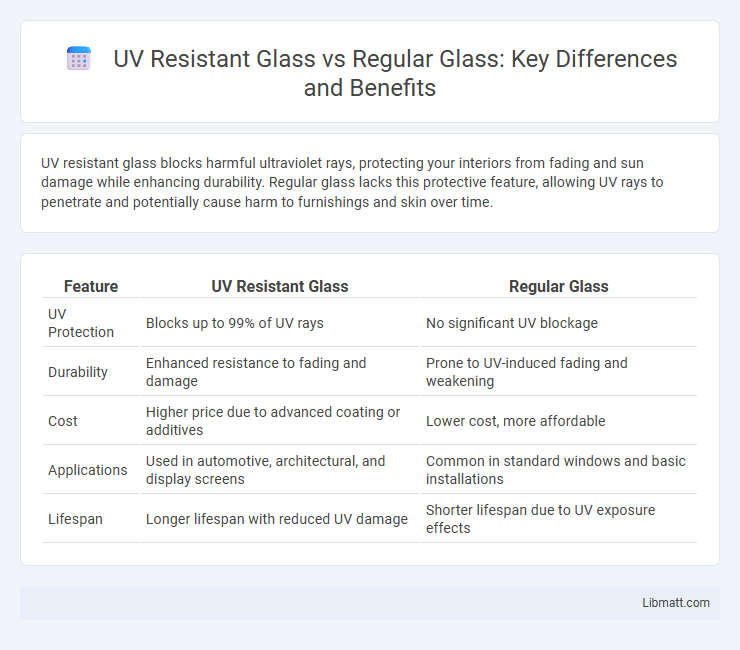UV resistant glass blocks harmful ultraviolet rays, protecting your interiors from fading and sun damage while enhancing durability. Regular glass lacks this protective feature, allowing UV rays to penetrate and potentially cause harm to furnishings and skin over time.
Table of Comparison
| Feature | UV Resistant Glass | Regular Glass |
|---|---|---|
| UV Protection | Blocks up to 99% of UV rays | No significant UV blockage |
| Durability | Enhanced resistance to fading and damage | Prone to UV-induced fading and weakening |
| Cost | Higher price due to advanced coating or additives | Lower cost, more affordable |
| Applications | Used in automotive, architectural, and display screens | Common in standard windows and basic installations |
| Lifespan | Longer lifespan with reduced UV damage | Shorter lifespan due to UV exposure effects |
Understanding UV Resistant Glass
UV resistant glass blocks up to 99% of harmful ultraviolet rays, significantly reducing the risk of skin damage and fading of interior furnishings. This specialized glass incorporates UV-blocking coatings or additives that absorb or reflect UV radiation, unlike regular glass which allows most UV rays to pass through. Commercial applications include automotive windshields, skylights, and museum displays to protect people and valuable artifacts from UV exposure.
Key Features of Regular Glass
Regular glass offers clear visibility and basic durability but lacks the ability to filter harmful ultraviolet (UV) rays, making it less effective at protecting interiors from UV damage and fading. It typically provides moderate insulation but does not include special coatings or treatments to enhance strength or UV resistance. Your choice of glass impacts long-term maintenance and comfort, with regular glass requiring additional measures to shield against UV exposure.
How UV Resistant Glass Works
UV resistant glass contains a special coating or additive that absorbs or reflects harmful ultraviolet rays, preventing them from passing through the glass. This protective layer helps reduce UV penetration by blocking up to 99% of UV radiation, which not only protects your skin but also prevents fading and degradation of interior furnishings. Regular glass lacks this feature, allowing most UV rays to pass through and contribute to potential damage over time.
Comparing Durability and Lifespan
UV resistant glass offers superior durability compared to regular glass by withstanding prolonged exposure to ultraviolet rays without yellowing or degrading. Its enhanced composition minimizes the risk of surface damage, ensuring a longer lifespan for windows, automotive glass, and protective covers. Choosing UV resistant glass helps protect your investments from the weakening effects of UV radiation, extending their functionality well beyond the typical lifespan of standard glass.
UV Protection Capabilities
UV resistant glass significantly reduces harmful ultraviolet radiation transmission by blocking up to 99% of UVA and UVB rays, offering superior protection compared to regular glass, which typically filters only a minimal percentage of UV light. This enhanced UV protection helps prevent skin damage and fading of interior furnishings while preserving natural light. In contrast, regular glass allows much higher UV penetration, posing greater risks for UV-related health issues and material degradation.
Energy Efficiency Differences
UV resistant glass significantly improves energy efficiency compared to regular glass by blocking up to 99% of harmful ultraviolet rays, which reduces heat transfer and lowers cooling costs. This type of glass helps maintain consistent indoor temperatures by minimizing solar heat gain, enhancing your home's overall energy performance. Choosing UV resistant glass can lead to substantial savings on energy bills and increased comfort throughout the year.
Applications in Residential and Commercial Spaces
UV resistant glass offers superior protection against harmful ultraviolet rays, making it ideal for residential spaces with large windows, skylights, and sunrooms where prolonged sun exposure can cause furniture fading and skin damage. In commercial spaces like office buildings, retail stores, and museums, UV resistant glass helps preserve merchandise, artwork, and interior finishes while reducing glare and heat gain for better energy efficiency. Your choice of UV resistant glass supports both aesthetic longevity and occupant comfort compared to regular glass, which lacks these protective features.
Cost Comparison: UV Resistant vs. Regular Glass
UV resistant glass typically costs 20-40% more than regular glass due to specialized coatings or laminate layers that block harmful ultraviolet rays. While the upfront investment is higher, UV resistant glass reduces potential damage to interiors, extending the lifespan of furnishings and lowering long-term replacement costs. Regular glass offers a lower initial price but lacks protection against UV degradation, potentially leading to higher expenses over time.
Maintenance and Care Requirements
UV resistant glass requires less maintenance compared to regular glass due to its protective coating that minimizes UV-induced degradation such as fading and discoloration. This glass is easier to clean since its surface repels dirt and reduces the likelihood of scratches caused by abrasive particles. Regular glass often demands more frequent replacement or treatments to preserve its clarity and structural integrity under prolonged UV exposure.
Choosing the Right Glass for Your Needs
UV resistant glass blocks harmful ultraviolet rays up to 99%, protecting interiors from fading and reducing health risks, while regular glass allows most UV rays to pass through. Your choice depends on whether you prioritize UV protection, energy efficiency, or cost, as UV resistant glass typically costs more but offers long-term benefits. For spaces with sensitive furnishings or high sun exposure, UV resistant glass ensures durability and comfort compared to standard glass.
UV resistant glass vs regular glass Infographic

 libmatt.com
libmatt.com